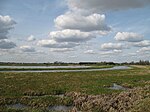St Nicholas Church, Feltwell
Church of England church buildings in NorfolkChurches preserved by the Churches Conservation TrustChurches with elements of Anglo-Saxon workEnglish Gothic architecture in NorfolkEnglish churches with Norman architecture ... and 4 more
FeltwellFormer Church of England church buildingsGrade I listed churches in NorfolkRound towers

St Nicholas Church is a redundant Anglican church in the village of Feltwell, Norfolk, England. It is recorded in the National Heritage List for England as a designated Grade I listed building, and is under the care of the Churches Conservation Trust. It has a partly collapsed west tower, and is unusual in being broader than it is long, having two side aisles and no chancel.
Excerpt from the Wikipedia article St Nicholas Church, Feltwell (License: CC BY-SA 3.0, Authors, Images).St Nicholas Church, Feltwell
Hythe Road, King's Lynn and West Norfolk
Geographical coordinates (GPS) Address Website External links Nearby Places Show on map
Geographical coordinates (GPS)
| Latitude | Longitude |
|---|---|
| N 52.4891 ° | E 0.5209 ° |
Address
Saint Nicholas
Hythe Road
IP26 4AE King's Lynn and West Norfolk
England, United Kingdom
Open on Google Maps








